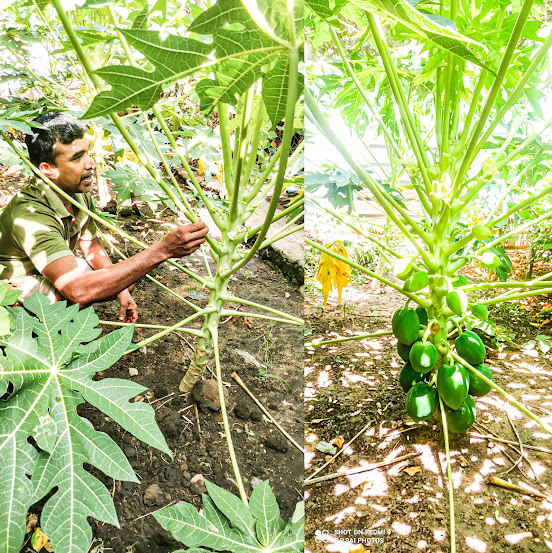The success story of a farmer on ‘Red Lady’ papaya cultivation by adapting climate-smart agriculture practices and technology in the climatically vulnerable hotspot area in Sri Lanka
The ‘Red Lady’ papaya is a hybrid. Normally, it grows in tropical regions. The ‘Red Lady’ papaya can be cultivated even in the home garden and can get yield consistently with good, tasty fruit along with better returns. Accordingly, the cultivation and production of this ‘Red Lady’ papaya through Vegetative propagation by adopting climate-smart agriculture practices were carried out successfully by a farmer (Sivakaran and his wife Sumithradevi) in the Komari–01 Grama Niladhari Division of Komari Agrarian Service Centre Division in Ampara District, Eastern Province.
In Sri Lanka, the ‘Red Lady’ papaya hybrid seed is comparatively expensive. Also, the ‘Red Lady’ papaya seeds are imported from other countries, and it is not available in small quantities required for Homestead gardening by every farmer. The farmer who is successfully propagating vegetatively through adopting the “air layering” Technique. Many seedlings can be produced from one ‘Red Lady’ papaya tree through Vegetative propagation at a very little cost within a short time, by a farmer in Ampara districts and also explained the technique of vegetative propagation, cultivation and production of the ‘Red Lady’ papaya seedling and fruits to the officials of the World Bank and Climate Smart Irrigated Agriculture Project and fellow farmers when they visited the subproject area in the Eastern Province.
The cost of one ‘Red Lady’ papaya seedling will be around Rs 750 – 900. Also, it takes at least a month to produce a ‘Red Lady’ papaya seedling (to grow to 1 feet height) using that seed. But with the very simple technique of vegetative production, one can produce excellent, healthy, ‘Red Lady’ papaya seedlings in one’s home garden within about fifteen days by using the air-layering method.
‘Red
Landy’ papaya air-layering method
In the home garden, the top part (shoot) of the ‘Red Lady’ papaya
tree should be cut off. Then, cover the cut ‘Red Lady’ papaya shoot with a
plastic bottle. The purpose of covering it is to prevent rainwater or other
water from entering the trunk of the cut ‘Red Lady’ papaya tree and to prevent
fungal invasion
After
15 days, the branch (seedling) that has developed roots should be cut and
separated and placed in a vase with the polythene (if it is for sale) or in the
ground for about 10 days under a shadow. After enough roots have formed, the
polythene can be removed. And when thin incisions are made from the base from
the bottom, the cells grow and the base enlarges. Due to this, the tree does
not break when the wind blows strongly. The speciality of the air-layering
seedling is that it starts bearing fruit 30 centimetres or one foot from
the ground within a period of three months unlike the seeds will produce fruits
only after a year. Each fruit from a new ‘Red Lady’ papaya tree weighs about
two to two and a half kilos.
The farmer said with a smile that by having 15 ‘Red Lady’ papaya trees, he
can earn nearly Rs. 40,000 per month. The most important thing here is that the
new papaya seedling will have the same characteristics as the mother tree
without any change in fruit taste, etc. Additionally, they can achieve better results in a short time to earn a continuous income. This ‘Red Lady’ papaya fruit is full of a sweet taste unlike other papaya fruits, and has a market opportunity that anyone
can come and buy.
Benefits
of the ‘Red Lady’ papaya air layering through registration
- A tree created by air layering will bear fruit continuously from a height of one and a half feet.
- The ‘Red Lady’ will never change the sweet taste of papaya fruit.
- Loss during the harvest of fruit can be completely avoided.
- Directly, the pest can be physically removed.
- Fruit can be obtained at a short height of the tree.
- It is also cost-effective and can generate recurring income.
- A single tree can produce several ‘Red Lady’ papaya seedlings at once.
Written by: Sharmila Thirhiharan, Gender
Development Officer of the Project Management Unit, CSIAP.
Photos and information by: T. Sekaran, Social
Safeguard Officer, and
P. Sai Purushothaman, Agriculture Facilitator,
Komari, EP, CSIAP.
Please click Video to watch


